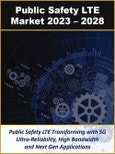Public Safety LTE to Transform with 5G Ultra-Reliability, High Bandwidth and Next Gen App
Speak directly to the analyst to clarify any post sales queries you may have.
This report provides an analysis of the global public safety LTE and 5G industry including assessment of the technology, market size, and key trends within the public safety LTE and 5G industry. The report includes public safety LTE and 5G market sizing and analysis from 2023 through 2028. The report evaluates the ecosystem including the major players, strategies, and offerings. It also assesses technology impact and the role of 5G in the evolution of public safety broadband.
The market for public safety and other mission-critical communications is rapidly developing as technologies are evolving to provide solutions necessary to meet the emerging demand for improved voice, data, and machine-oriented communications. The public safety community increasingly relies upon IP-based solutions for first responders (ambulance, police, and fire) and dispatch communications as well as overall coordination in the event of a disaster.
Next-generation public safety communications infrastructure is required to handle a variety of communications traffic in real-time and with the highest QoS possible. As the exact occurrence of emergencies cannot be predicted, these QoS requirements are on-demand and cannot be scheduled like many other mission-critical services. This translates into guaranteed service levels on a 24/7 basis rather than the best-effort services of traditional IP based services in non-mission critical public networks.
LTE and 5G offer the most advantageous solutions for secure wireless broadband networks, which need to support the unique devices, communications, and content delivery requirements of public safety organizations.
Nonetheless, commercial wireless broadband equipment and networks were not originally developed with first responder applications in mind. To optimally address the next-generation communications needs of the public safety community, vendors are developing dedicated, secure LTE and 5G networks with equipment optimized for emergency services applications.
While seemingly a misnomer, public safety networks are actually private wireless networks in the sense that they are dedicated for use by first responder communications and sharing information between PSAPs and other emergency services personnel and resources. In other words, public safety networks provide a public service, but are secured and dedicated for purposes of ensuring the accuracy, timeliness, and reliability of emergency response and coordination.
Accordingly, dedicated resources are allocated at both the hardware, software level leveraging virtualization, SDN, and other supporting technologies. 5G will have a key role in this regard through advanced capabilities such as network slicing.
Supporting technologies such as edge computing will have an important role in supporting ultra-reliable low latency communications (URLLC) for both voice and URLLC enabled applications such as augmented reality and public safety video and content sharing.
With the purchase of this report at the Multi-user License or greater level, you will have access to one hour with an expert analyst who will help you link key findings in the report to the business issues you're addressing. This will need to be used within three months of purchase.
This report also includes a complimentary Excel file with data from the report for purchasers at the Site License or greater level.
Table of Contents
1. Executive Summary








